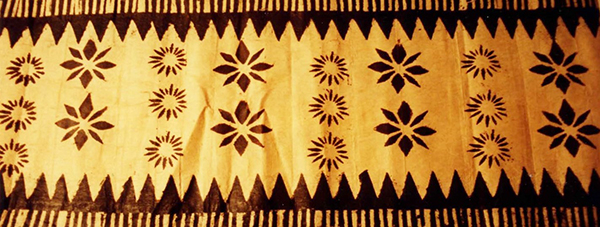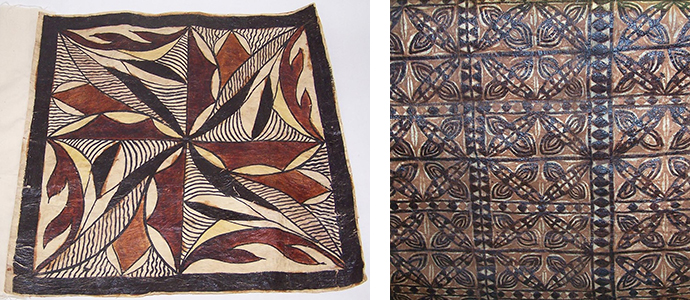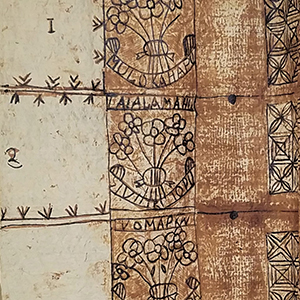Pacific Islands: Paint a Tapa Cloth
As May ends, we continue to celebrate Asian American and Pacific Islander Heritage Month with this post about tapa cloth.
Tapa Cloth
Tapa cloth, also called bark cloth, is found throughout the Pacific Islands of Hawaii, Fiji, Papua New Guinea, Samoa, and others. Tapa cloth is the generic term, but it has different names on different islands: Samoa-siapo, Hawaii-kapa, Fiji-masi, and Tonga-ngatu.
Indeed, the creation of tapa cloth is directly connected to the origins of Pacific Island cultures. Evidence suggests that the process of making bark cloth was carried out of Southeast Asia by the first peoples that migrated to the South Pacific islands. As peoples settled on the various islands, they developed a type of tapa cloth production and symbolism that fit their changing cultural needs. The creation of tapa cloth has continued to evolve throughout the history of the Pacific Islands and remains an important part of the societies, religions, and cultures of today.

How It’s Made
Tapa cloth is one of the most distinctive items made by the many cultures of the Pacific Islands. It is a cloth made from the pounded inner bark of mulberry or fig trees. Raw material is taken from young trees, dried, soaked, and then beaten with a wooden mallet. The flattened bark is spread into very thin sheets and dried in the sun. These sheets are combined to make a tapa cloth. Click here to see a video showing tapa cloth being made in Samoa.
Decoration is added to tapa cloth once it is dried. Artists mix plant dyes and use other natural materials to create organic and geometric shapes on the cloth. Tapa cloth is usually painted or stamped and sometimes a combination of both techniques is used. Underlying designs on larger tapa cloths are embossed with woodblocks or stencils and then other designs are painted on top.

Uses

Tapa cloth is a versatile fabric which is used for both functional and ceremonial purposes. It plays an important role in gift giving, commemorations, weddings, funerals, and events associated with royalty. Tapa cloth is used to make items like clothes, blankets, bedding, bandages, room dividers, floor mats, mosquito screens, dancing costumes, and so much more.
Let’s Make and Paint a Tapa Cloth!
There is a lot of room for creativity, so have fun with this art project!
You will need:
- Brown paper bag or brown craft paper
- Newspaper or something to cover your work area
- Craft paints
- Paint brushes, stamps, and objects to make geometric shapes
- Pencil (to draw or trace shapes)
- Eraser
- Water container
- Paper plate for paints
- Paper towels
Optional:
- Spray bottle with water
- Crayons
This project can be done with crayons. You won’t be able to stamp designs, but you can draw and color designs with the crayons.
Directions:
- Cover the work area with newspapers or something that protects the work surface.
- Start with a brown paper bag or piece of craft paper and tear a large section of it so the edges are a bit ragged.
- Crumple the paper tightly, unfold, and flatten it. Do this several times. To soften the paper and make it easier to crumple, spray a bit of water on it. Crumpling and flattening the paper will make it look more like cloth. If you do dampen the paper, allow it to dry thoroughly before decorating.
- Using black paint or crayons, make lines to divide the tapa cloth into smaller sections.
- Using other colors, paint, stamp, or draw geometric shapes inside each of the smaller sections. Add lines, dots, squiggles, leaf, and flower shapes but also leave some of the brown paper showing through. Use any design to create a unique tapa cloth.
- If paint is used, let the first layer dry, then you can create smaller shapes on top of the larger designs. Crayons won’t allow you to create designs on top of other designs.
- Let dry completely.
Here’s another way to make tapa cloth from the Merced Multicultural Arts Center:
Learn more about tapa cloth in the Lam Museum’s collection with this Artifact of the Month post.
